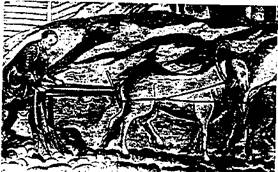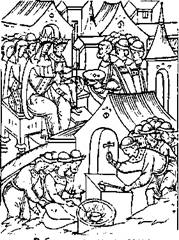home
 Economy Economy
 books books
 The history of the world economy - Polyak GB The history of the world economy - Polyak GB
|
The history of the world economy - Polyak GB
15.2. Features of economic development of Russia in the XVI century.
By the beginning of the XVI century. largely completed the process of unification of the North-Eastern Russia around Moscow. On the political map of Europe, there was a huge power, called Russia. The dimensions of its territory shocking rulers of many European states. Now Moscow Russia can not be ignored in establishing economic relations with Eastern European countries.
Agriculture
The population of Russia to the beginning of the XVI century. It was about 6 million. man. The main branch of the economy was agriculture, it has been the main occupation of the population. In connection with the spread of three-field crop rotation to increase yields significantly. Further developed horticulture and gardening. Livestock is not very productive and play a subordinate role in the economy. The farms were kept horses, cows, sheep, goats, pigs.

plowing farmer
From the XVI century. improved farming machinery. Now the main tillage tool - dvuhzubaya plow. At the ends of these teeth skewer iron plowshares (ralniki). In addition, the plow had a knife rifling-tion plowed land formation, blades or the police (for otgrebaniya land). Soha - relatively moving a tool, one of the horses harnessed to it. Soha was produced different kinds, depending on the local conditions (plow "Vladimirka" "Vyatka", "Kostroma deer" and others.).
Among other farm implements used harrows, scythes, sickles, plowshares (wood and iron).
Raising the level of agriculture contributed to the use of non-black in the central districts of manure, which is already included in the delivery of one of the normal duties of the peasants.
As draft animals used oxen and horses, the number of which in large boyar and monastic estates amounted to several hundred.
For the organization of agricultural production has been an important issue of manpower. In the XVI century. in Muscovy first it appears a special kind of bondage - enslaving bondage arising on a purely economic basis of the loan (bondage - the receipt of the loan). Instead, temporary, before the payment of the debt, it gradually turns into a permanent and lifelong.
Operation of the rural population in the XVI century. even more intensified. From the middle of the century to the execution of works barshchina except slaves involved all the peasants who lived in the land of its owner. Corvee reaches four days a week. The feudal lords seeking to expand their acreage by plowing peasant holdings. Size lordly plowing achieved mainly 35-50% of all the land, and in the monastic estates - 40%.
Due to the devastation of the Mongol-Tatar cities and the loss of many kinds of crafts began to develop rural handicraft production, which meet consumer demand in a variety of products and serve as an additional source of income for farmers.
In the cities, restoring the economy went the urban population, there were new settlements, began to recover and develop handicraft production.
Urban development. handicraft industry
In the XVI century. there is a process of deepening social division of labor, the development of crafts, trades, commerce. Many new towns, settlements, Torzhok, trading, rows. Revives old city. It emerged in the second half of the XVI Of the available 232 cities in Russia, 72 in. Most major cities had great socio-economic importance, were Moscow, Novgorod, Rostov, Vladimir, Pskov, Smolensk, Yaroslavl, Pereslavl, Nizhny Novgorod, Vologda, Ustyug, Kazan, Astrakhan.
Moscow was not only the capital of the Russian state, but also a center of handicraft production, domestic and foreign trade. That's from Moscow in different directions diverge land and river routes linking the remote areas.
However, despite the development of cities, the proportion of urban population in the Russian State in XVI. It was negligible, and the cities were still in the feudal system of relations: whole urban areas were owned by the boyars that impeded their socio-economic development.
An indicator of the deepening social division is the development of handicrafts. There are about 220 kinds of handicrafts.
On the importance of crafts in the life of the cities of the Russian state XV-XVI centuries. indicates the number of craft of the population in the cities. So, in Moscow and Novgorod were more than 2 thousand artisans in the county-level cities (Kolomna, Mozhaisk, Tula.) - Several hundred. Artisans posads these belonged to the "black", the tax court, and the state in the interests of the fiscus take into account their number.
The predominant craft groups were producers victuals:. Khlebnikov, Ponds, Pirozhnikov, kvass, distillers, etc. The next largest group of urban artisans were manufacturers of garments:. Sukonniki, tanners, shoemakers, etc. Then followed a group of artisans for the production of household items.
For urban crafts XVI century. characterized granularity - differentiation of certain types of crafts to independent craft specialty. So, among the tailors craftsmen are increasingly met svitniki, kaftanniki, Shubnikov, sarafanniki, dushegreechniki.

Forge
The second notable feature in the development of crafts - the deepening of the technical division of labor within individual specialties.
Typical for the preceding centuries, the work of artisans to order began to lose its significance. It causes the growth of the urban population, the deepening of the territorial division of labor and increasing exchange between the individual regions of the country. Demand for the products of urban craftsmen growing not only among citizens but also among the feudal lords and the peasants. Thus, the urban artisans turned to small-scale producers.
The changes affect agriculture and trade, which is reflected in the appearance of entire craft fishing areas served remote areas. There were areas for the production of fabrics (canvas, sermyaga, krasheniny), areas of the skin processing and production of leather products, areas of metallurgical, woodworking production, business and so picturesque. D.
Russia especially in relation to organizational forms of urban craft guild was the lack of organization of the handicraft of the population as an industrial estate and guild regulation of trade. Unlike Western Europe, where craftsmen were influential urban bourgeoisie, in Russia, they are for the most part belonged to the lower class of the city, the urban poor, living in huts Qurna, on the outskirts of the city, receiving low wages.
Manufactory. crafts
In the XVI century. first manufactories appeared in Russia. These include centralized manufactory in foundries, where they began to produce guns, bells. Here, a complex process. He was supposed to take place under the supervision of master craftsmen; it was attended by the master professionals and laborers. Bells in the XVI century. cast has enormous dimensions.
Centralized textiles consider cannon yards. In the XVI century. manufacture of guns of various types and purposes grow in magnitude. Expand the production of cannonballs. In 1586, at the largest cannon yard of the country - Moscow Andrei Chekhov was cast "Tsar Cannon" weighing 2400 pounds.
The dressing of weapons and military equipment of the army large-scale production has played a particularly important role. When Ivan IV the gun began to cast iron.
Artillery guns were manufactured at the king, urban and patrimonial enterprises of different types, purpose and size. It squeaked, mortars, howitzers, firing stone balls, grapeshot cannon, heavy siege and fortress, and others. Transportation of heavy guns was difficult. So, for the conquest of Kazan gun sent the water, they were three months. But the artillery played a decisive role in the siege, to break through the walls of the Kazan Kremlin to attack.
For centralized manufactories include mints. Thus, in the Pskov Mint had separate facilities for making molds for casting coins; premises where "pulled silver", as well as premises for minting coins. It worked casters, wiredrawer, chasers, soldiers, Blacksmiths. It says the introduction of the technical division of labor. In the XVI century. these mints were in Moscow, Pskov, Novgorod.

Works in the money courtyard
Centralized manufactory witnessed the birth of large-scale industry in Russia.
Further developed in the XVI century. crafts. Some of them demanded the mass application of labor and their technical and economic characteristics do not fit into the framework of handicraft production and landlord economy. Of these the most important industries got salt production, and potash mining, metallurgy and others. Such enterprises often use "free" labor, especially skilled foreign workers.

Salt works on the river. Mshage
If the above iron and hydrochloric matter organized in manorial or monastic farms, in the XVI century. in particular of salt appear larger solepromyshlenniki plant in its own bailiwick large trades.
The largest solepromyshlennikami XV-XVI centuries. It was the famous Stroganoff - the ancestors of future large-scale commercial and industrial bourgeoisie. They took place from Solvychegodsk peasants. Stroganovs owned numerous large saltworks on Ustyug, the Kama in Perm, in the Urals. First Salt Plant was founded by them in 1515
Salt pans were the main branch of the economy in the Stroganoff. Development of underground salt solutions require a lot of money. For their development acquired vast holdings, individual Varnitsa, villages with the peasants; taken on all kinds of work people. Admission - bondage, rents, hiring. Each salt furnace were employed craftsmen and workmen of different specialties: salt works, cooks, podvarki, vodolivy, pipe makers, prenniki, blacksmiths, carpenters, lumberjacks, carters. Besides production Stroganovs salt producing potash, furs bought, sold it, and others. The companies Stroganov worked up to 10 thousand. Of free workers and up to 5 thousand. Serfs.
Tula, Tikhvin, Zaonezhie became centers of iron production. Vologda, Yaroslavl, Novgorod famous for its tanners.
As before, the population engaged in the hunting of fur-bearing animals, wild boars, bears, sea mammals, birds. Furs in great demand not only in domestic but also in international markets. Fisheries cooperatives engaged mainly fishermen professionals.
In the northern strip - from Pskov to Kholmogory and Yaroslavl - developed dairy and meat cattle breeding.
Expand and strengthen the link between local markets. Major trading centers are not only Moscow, but Kholmogory, Nizhny Novgorod, and later Kazan, Astrakhan. In the Volga region it was founded by the city: Samara, Saratov, Simbirsk, Tsaritsyn.
Russia Out in the second half of the XVI century. to the Caspian Sea has led to increased trade with the North Caucasus, Persia, the Caucasus, Central Asia. The Russian steel imported Indian and Chinese goods: silk, dyes, spices, fabrics, china. To establish stronger links with Britain and the Netherlands, with which trade was mainly through the port of Archangel, built by Ivan the Terrible.
Ivan IV reforms
XVI century - is, above all during the reign of Ivan IV - the Grand Duke of Moscow and All Russia and the first Russian tsar. In the years of his childhood in his name ruled princely-boyar factions fought for power and increase the feudal tyranny. Upon reaching adulthood, Ivan IV in 1547 receives the title of king. It focuses its efforts on the centralization and strengthening of autocratic power. In the late 40-ies. in the country deteriorated social situation, they have been suppressed popular uprisings in Pskov, Veliky Ustyug, Gorokhovets and other places. In the situation of the struggle within the feudal class, Ivan IV relied on the nobility and the support of the upper quarter.
In those years, when Ivan IV was formed a circle of government - Selected pleased, which is an informal government of the Russian state in the 1547-1560 biennium. It included a nobleman A. Adashev, priest Sylvester, Metropolitan Macarius, Prince A. Kurbsky. Selected glad held a series of reforms that contributed to the development of the Russian economy. Thus, at the initiative of the Selected glad in 1549 it was called the first Zemsky Sobor to address major public policy issues. And in 1550, a new Code of Law, which in addition to Sudebnik 1497 confirmed the St. George's Day, but it increased the "elderly (feudal fee when switching from one landowner to another), limited the transition of the peasants, which helped further their enslavement was created. New Law in increased dependence of the peasant by the lord, and that required to call him "the emperor."

Bolshany state seal of Ivan the Terrible
The first central government agencies have been created by the will of the Selected glad - orders (petitions, the local, armed, bit, etc.).
In 1551, he was summoned Stoglavy Cathedral, got its name from the collection of the decisions made was 100 chapters. Ivan IV of, to meet the wishes of the church leaders, proclaimed the inviolability of church property. However, the monasteries were forbidden to found new settlements in the cities, to make a gift and buy land without the permission of the king's government. "Stoglav" was a major collection of norms of the inner life of the clergy in the XVI- XVII centuries. In 1556 he was elected as glad canceled "feeding" system that provided additional inflow of funds in the treasury and set a new national tax - pososhnuyu file. It was also carried out military reform.
In 1560 he was elected as glad was eliminated by Ivan IV, who wanted to strengthen his personal power and the discharge of a vigorous and independent-minded people management.
In the period of the Chosen glad Russia has moved from the early feudal to the estate-representative monarchy. There are estate-representative institutions - Zemsky Sobor. They are convened by the Government to discuss the most important issues of domestic and foreign policy, playing the role of deliberative bodies. The right of convening councils belonged to the king.
The detrimental effect on the development of the Russian economy had a introduction oprichnina Ivan the Terrible (1565-1572). By decree of the king announced the establishment of a "special" court with a special area, the army (originally consisted of about a thousand people), finance and administration (oprichnina Duma). The oprichnina, t. E. The king's inheritance entered the territory in the west, north and south of the country, the land with the most-developed specific princely landownership. There were the most developed cities (Yaroslavl, Rostov, Kostroma, etc.), Were important trade routes, strategic outposts on the borders. Revenues from oprichnina lands had come into the coffers of the sovereign. In these areas, he settled nobility, formed the so-called oprichnina army, which is subject only to the king. This organization has become punitive authority to carry out executions, exile, disgrace. Were defeated Klin, Torzhok, Tver, Novgorod and other cities, opposed the introduction of the oprichnina. The government has introduced a lack of jurisdiction guardsmen public authorities and courts.
The rest of the state was named zemshchina. She still managed Boyar Duma, forced on all important issues to seek the agreement of the king.
Oprichnina was essentially an agrarian revolution in the middle of the XVI. Its essence was the redistribution of land in favor of the boyars, the nobility, the elimination of the independence of a large fiefdom-princely landownership and strengthening of the central imperial power. Oprichnina played a major role in strengthening the economic power of the king. Ivan the Terrible cruelly punished nobles and princes. Of the 200 after oprichnina boyar families were no more than half a dozen. In disgrace to confiscate not only the disgraced human property, but its documents (certificates) for the right to use the land and the people living on it. Punitive actions have caused anger in all segments of the population. The king was forced in 1572 to abandon the oprichnina.
Certain influence on the country's economy had a foreign policy of Ivan the Terrible. They were conquered Kazan (1552) and Astrakhan (1556) Khanate. all the Volga region, the Western Ural region became the property of Russia; dependence on Russian tsar recognized nagayskie and Kabardinian rulers. But Russia's defeat ended lasted a quarter century Livonian War for the possession of the Baltic Sea.
On the Russian economy development significantly affected by the accession of Siberia, made possible in the last quarter of the XVI century. thanks to a number of factors.
1) Development of trade and financial relationships has led to the expansion of Russian foreign trade relations with other countries and especially in high demand in European countries used the Russian furs.
2) At the same time extended segments of the population (peasants, Cossacks, voluntary and industry people), formed the basis for the settlement of Siberia.
3) Окрепшее централизованное государство обладало достаточными военными и финансовыми возможностями для присоединения огромной, трудно осваиваемой территории, населенной различными народами (ханты, манси, эвенки, буряты, якуты, хакасы и др.).
4) Важную роль в присоединении Западной Сибири сыграли купцы и промышленники Строгановы. Получив разрешение от Ивана Грозного выдвинуть форпосты на Обь и Иртыш, они пригласили в 1577 г. отряд казачьего атамана Ермака Тимофеевича для защиты своих владений от набегов сибирского хана. В 1581 г. Ермак с отрядом в 1650 человек выступил в поход. Царь послал на помощь Ермаку стрельцов. Войска хана Кучума были разбиты на реках Тобол и Иртыш. Сибирское ханство распалось. В 1585 г. Ермак погиб в бою. Прхйдом Ермака было положено начало присоединению Сибири к Российскому государству.
Царское правительство было заинтересовано в удержании и расширении сибирских владений, посылало в Сибирь своих воевод с ратными людьми, поручая им строить укрепленные города и остроги. В Сибирь выселялись и ехали добровольно крестьяне, стремившиеся завладеть обширными земельными угодьями.
Опричнина и Ливонская война привели в упадок хозяйство страны, усилили бегство крестьян из родных мест — центр и северо-запад оказались опустошенными. Поэтому в некоторых районах страны в 1581—1582 гг. был временно запрещен переход крестьян к новым хозяевам (отмена Юрьева дня).


Comments
Commenting, keep in mind that the content and the tone of your messages can hurt the feelings of real people, show respect and tolerance to his interlocutors, even if you do not share their opinion, your behavior in terms of freedom of speech and anonymity offered by the Internet, is changing not only virtual, but real world. All comments are hidden from the index, spam control.